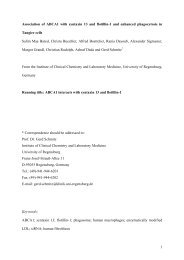Revealing Early Steps of 2 1 Integrin-mediated Adhesion to ...
Revealing Early Steps of 2 1 Integrin-mediated Adhesion to ...
Revealing Early Steps of 2 1 Integrin-mediated Adhesion to ...
You also want an ePaper? Increase the reach of your titles
YUMPU automatically turns print PDFs into web optimized ePapers that Google loves.
Puech et al., 2005). Cells were pressed on<strong>to</strong> the collagen<br />
matrix with a predefined contact force for varying times.<br />
Subsequently, the cantilever was retracted until the cell was<br />
detached from the matrix. A complete force measurement<br />
cycle is depicted schematically in Figure 2B. From the corresponding<br />
force curve the maximal detachment force (F),<br />
corresponding <strong>to</strong> the maximal cantilever deflection during<br />
retraction, was determined (Figure 2C). Force curves usually<br />
displayed several small unbinding events, either preceded<br />
by a force plateau (“t”) or not (“j”). Sections <strong>of</strong> the force<br />
curve describing j events showed a nearly linear increase<br />
preceding the point <strong>of</strong> rupture and were considered <strong>to</strong> represent<br />
the unbinding <strong>of</strong> discrete adhesive units under load.<br />
In contrast, no force loading (increase in force) occurred<br />
before t rupture events. Such t events were interpreted as<br />
membrane tether extrusions from a large cell membrane<br />
reservoir (Raucher and Sheetz, 1999). Because the force step<br />
analysis in this study required constant-rate, nonzero bond<br />
loading before rupture, values <strong>of</strong> t events were excluded.<br />
Due <strong>to</strong> the viscoelastic response <strong>of</strong> the cell <strong>to</strong> the cantilever<br />
force during substrate contact (Puech et al., 2006), the end <strong>of</strong><br />
the approach curve and the beginning <strong>of</strong> the retraction curve<br />
were shifted along the force axis (Figure 2C, inset). The<br />
viscoelastic deformation <strong>of</strong> the cell usually occurred within<br />
�2 s after reaching the predefined contact force and resulted<br />
in a decrease <strong>of</strong> the cell diameter by �10–15% and a drop <strong>of</strong><br />
the effective contact force by several hundred piconew<strong>to</strong>ns<br />
(see Supplemental Movie S1). For contact times �120 s,<br />
usually two <strong>to</strong> five force cycles per cell were performed,<br />
whereas for longer contact times, one or two force curves per<br />
cell were recorded. To ensure that the contact his<strong>to</strong>ry <strong>of</strong> the<br />
cells with the matrix did not influence the force measurements,<br />
cells were allowed <strong>to</strong> rest for 2 <strong>to</strong> 3 minutes after each<br />
force measurement cycle (see Supplemental Figure S2).<br />
When testing different spots on the collagen matrix or repeating<br />
a force cycle at the same position, similar force<br />
curves were obtained, indicating that the matrix integrity<br />
was not compromised during the cell pulling experiments<br />
(see Supplemental Figure S3).<br />
Representative force curves for CHO-A2 (<strong>to</strong>p curve) and<br />
CHO-WT (middle curve) cells after a cell–matrix contact<br />
time <strong>of</strong> 5 s are shown in Figure 3A. For CHO-A2 cells, we<br />
obtained force curves characterized by maximal detachment<br />
forces <strong>of</strong> up <strong>to</strong> 600 pN and several single-rupture events. In<br />
contrast, CHO-WT force curves displayed drastically reduced<br />
detachment forces and usually lacked discrete unbinding<br />
steps. In Mg 2� -free medium, adhesion <strong>of</strong> CHO-A2<br />
cells was blocked (Figure 3A, bot<strong>to</strong>m force curve). Conversely,<br />
CHO-A2 cell adhesion was fully res<strong>to</strong>red when 0.8<br />
mM Mg 2� was added <strong>to</strong> the medium (data not shown).<br />
Figure 3B displays a his<strong>to</strong>gram <strong>of</strong> CHO-A2 and CHO-WT<br />
cell detachment forces after a contact time <strong>of</strong> 5 s. CHO-A2<br />
cell detachment forces showed a relatively wide distribution,<br />
ranging from �40 <strong>to</strong> 600 pN, whereas CHO-WT cell<br />
detachment forces showed a narrower distribution and<br />
never exceeded 150 pN. The mean CHO-A2 cell detachment<br />
force (189 � 12 pN; mean � SD) was almost 4 times higher<br />
than for CHO-WT cells (49 � 7 pN). Between 5 and 120 s <strong>of</strong><br />
substrate contact, the CHO-A2 mean detachment force increased<br />
by almost 1 order <strong>of</strong> magnitude, whereas the<br />
CHO-WT mean detachment force increased only slightly<br />
during the same time interval (Figure 3C). In the absence <strong>of</strong><br />
Mg 2� , adhesion <strong>of</strong> CHO-A2 cells was significantly reduced<br />
for both contact times and comparable with CHO-WT cells<br />
(Figure 3C). The SCFS measurements demonstrated clearly<br />
that for two different contact times CHO-A2 cells adhered<br />
� 2� 1 <strong>Integrin</strong> Force Spectroscopy<br />
Figure 3. Measuring � 2� 1-dependent cell adhesion by SCFS. (A)<br />
Representative force distance curves (retrace) for CHO-A2 and<br />
CHO-WT and CHO-A2 cells in the absence <strong>of</strong> Mg 2� after a 5-s<br />
collagen matrix contact time. Force curves were recorded at a pulling<br />
speed <strong>of</strong> 2.5 �m/s. For CHO-A2 cells, a series <strong>of</strong> single-rupture<br />
events can be observed. CHO-A2 did not adhere in absence <strong>of</strong><br />
Mg 2� . (B) Distribution <strong>of</strong> detachment forces for CHO-A2 (50 cells)<br />
and CHO-WT (11 cells) after a contact time <strong>of</strong> 5 s. (C) Comparison<br />
<strong>of</strong> the maximal detachment forces (mean � SEM) for CHO-WT cells<br />
and CHO-A2 cells with and without Mg 2� .<br />
more strongly <strong>to</strong> the collagen matrix than CHO-WT cells<br />
and that CHO-A2 cell adhesion was strictly Mg 2� dependent.<br />
The requirement <strong>of</strong> both integrin � 2 expression and<br />
extracellular Mg 2� showed that adhesion <strong>to</strong> the collagen<br />
matrix was <strong>mediated</strong> by � 2� 1. These results were consistent<br />
with the different spreading behavior <strong>of</strong> CHO-A2 and<br />
CHO-WT cells on the collagen matrix.<br />
Investigating Single � 2� 1-Mediated <strong>Adhesion</strong> Events<br />
To further explore � 2� 1-<strong>mediated</strong> collagen binding, the<br />
SCFS setup was adjusted <strong>to</strong> perform force measurements<br />
with single-molecule sensitivity. To reduce the contact area<br />
between cell and matrix, CHO-A2 cells were pressed on<strong>to</strong><br />
the collagen substrate with low contact force (100–200 pN)<br />
Vol. 18, May 2007 1637
















